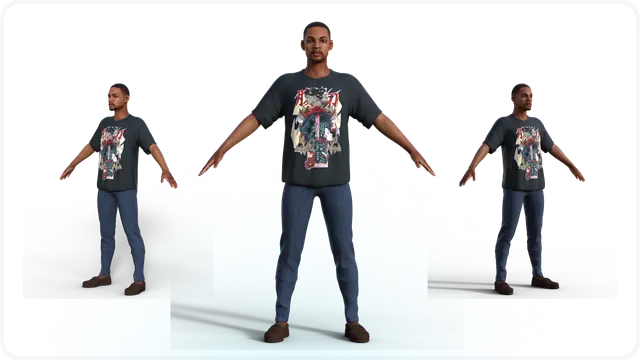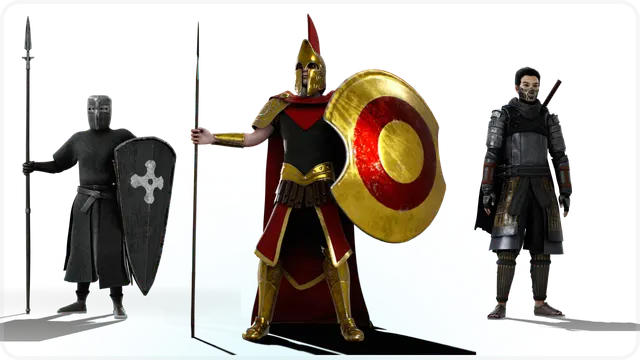Advertisement serves as the heartbeat of brand promotion that connects businesses with their target audience. Through this powerful medium brands convey their messages, showcase their uniqueness, and establish a identity in the market. In an era where consumer attention is a precious commodity, effective advertisement becomes indispensable. It not only creates awareness but also influences consumer perceptions and behaviours.
Moreover, as we look forward to the digital landscape, traditional advertising methods are making way for innovative approaches. That’s where 3D models comes in, a revolutionary in modern advertising. These 3D assets transcend the limitations of 2D visuals, offering a dynamic and engaging means of communication. 3D models bring a sense of realism and interactivity to the table, elevating the overall brand experience. From showcasing products with intricate details to crafting captivating narratives, 3D models have become the avant-garde of advertising creativity.
So, now in this blog we will discuss the symbiotic relationship between time-tested advertisement tips and the integration of 3D models. By combining the basics of effective brand promotion with the creative boost from 3D assets, we will unlock the ability to make powerful and unforgettable advertising campaigns.
Advertisement Tips for Brand Promotion
Online Advertisement: Importance of Online Projects in Contemporary Advertising
Online projects serve as the canvas for brand narratives. From dynamic websites to immersive online campaigns, the virtual realm provides an expansive playground for brands to engage with their audience. Successful brand promotion requires a keen understanding of how online projects can be leveraged to tell compelling stories and connect with the target market.
A successful brand promotion in the digital space demands an understanding of the basics. From search engine optimisation (SEO) to user experience (UX) design, every element plays a crucial role in shaping the success of brand promotion. It’s not just about being present online; it’s about creating a digital footprint that resonates with the audience and fosters brand loyalty.
Marketing Strategies for Business Advertising:
Crafting a successful marketing strategy involves a detailed understanding of the brand, its audience, and the competitive landscape. Whether it’s through traditional or digital channels, a well-rounded approach is essential. From content marketing to influencer collaborations, businesses must strategically deploy their resources to maximise visibility and impact.
The Role of Online Marketing in the digital marketplace emerges as a powerful tool for reaching a diverse and global audience. Utilising platforms such as social media, search engines, and email marketing can exponentially amplify brand messages. A successful marketing strategy integrates these online channels seamlessly, ensuring a broad and impactful reach.
Leveraging Social Media Marketing for Advertising Campaigns:
Social media has evolved from being a mere communication platform to a dynamic marketplace. Brands that successfully integrate social media into their advertising campaigns tap into a vast and engaged audience. The ability to share stories, interact with consumers, and leverage user-generated content makes social media an invaluable tool in the modern advertising arsenal.
Effectively navigating social media requires more than just posting content. Tips for successful social media marketing encompass understanding platform algorithms, creating shareable content, and fostering community engagement. By building a strong social media presence, brands can enhance their visibility and forge meaningful connections with their audience.
Benefits of Using 3D Models in Brand Promotion and itsImpact on Advertisement:
In the dynamic landscape of advertising, static visuals are no longer sufficient. The introduction of 3D assets marks a paradigm shift, offering a new dimension to storytelling. These assets, ranging from lifelike product models to immersive environments, redefine the visual language of advertising.
The benefits of incorporating 3D models into advertising are manifold. Enhanced visual appeal grabs the audience’s attention, while the ability to showcase products and concepts in intricate detail adds a layer of sophistication. From engaging visuals to increased interactivity, 3D models offer a versatile toolkit for crafting compelling brand narratives.

Advertisement Tips with 3D Model Integration
Tip 1: Engaging Visual Content with 3D Models
In the competitive landscape of advertising, the visual allure of content is unparalleled. Brands vying for attention must understand that captivating visuals serve as the initial gateway to audience engagement. Visual appeal not only captures attention but also establishes a connection with the viewer, making it a pivotal factor in the success of any advertisement campaign.
3D models is a transformative force in elevating the visual appeal of advertisements. These dynamic assets inject a sense of realism and depth into visuals, transcending the limitations of traditional 2D graphics. The intricate details, realistic textures, and fluid movements of 3D models captivate the audience, creating an immersive experience that leaves a lasting impression.
Tip 2: Personalized 3D Character Models
Brand identity is the cornerstone of recognition and loyalty. In a sea of competitors, establishing a unique and memorable brand identity is paramount. Personalized 3D character models offer a bespoke avenue for brands to distinguish themselves. These models become the face of the brand, embodying its values and personality in a visually compelling manner.
Consider the M&M’s characters or the iconic Michelin Man—these are not just mascots; they are personalised 3D character models that have become synonymous with their respective brands. These examples highlight the power of character-driven branding, creating not just products but companions that consumers connect with on a personal level.
Tip 3: Showcasing Products with 3D Product Models
In the realm of product advertising, showcasing features effectively is key to driving consumer interest. 3D product models go beyond static images, offering an interactive and detailed representation of products. From intricate design elements to a 360-degree view, these models enable brands to highlight product features in a visually compelling and informative manner.
Consider Apple’s product launches, where 3D models take centre stage, allowing users to explore the sleek design and functionality of each device virtually. Such case studies exemplify the impact of 3D product models in creating immersive and informative product advertisements that resonate with consumers.
Tip 4: Humanizing Your Brand Advertisement with Human Assets
Behind every brand, there is a story waiting to be told. Human assets play a pivotal role in brand storytelling by adding a relatable and emotional dimension. Whether it’s through the depiction of real people or custom-created characters, human assets foster a connection with the audience, making the brand more approachable and authentic.
3D human assets, whether animated characters or lifelike representations, bring brands to life. They become the storytellers, conveying the brand narrative in a way that resonates with the audience. By humanising the brand, 3D human assets create an emotional bond, transforming consumers into loyal advocates.
Tip 5: Interactive 3D Advertisement
In the digital age, passive consumption is giving way to interactive experiences. Interactive 3D advertisements redefine engagement by allowing users to actively participate in the brand narrative. From clickable elements to immersive virtual tours, interactivity enhances user engagement, making the advertisement an experience rather than a mere viewing.
Consider incorporating gamification elements, allowing users to manipulate and explore 3D scenes. Interactive quizzes or virtual try-ons are also effective strategies. These tips ensure that the audience not only views the advertisement but actively engages with and remembers the brand.
Tip 6: Consistency Across Platforms in Advertising
Brand consistency is the bedrock of recognition and trust. In a multi-channel world, where consumers encounter brands across various platforms, maintaining a cohesive and recognisable brand image is crucial. Consistency instils confidence, assuring consumers that the brand they encounter online aligns seamlessly with their offline experiences.
Integrating 3D models ensures a consistent visual language across platforms. Whether on social media, websites, or mobile apps, the use of consistent 3D elements reinforces brand identity. This visual continuity fosters a sense of familiarity, making it easier for consumers to connect with and remember the brand.

Tip 7: Incorporating 3D Models in Online Projects
As online projects become more sophisticated, the seamless integration of 3D models becomes imperative. Whether it’s a website, a virtual tour, or an interactive campaign, the integration must feel natural and enhance the overall user experience. The goal is to elevate online projects from static displays to immersive and dynamic experiences.
From e-commerce websites offering 3D product previews to virtual events with immersive 3D environments, these examples showcase the versatility of 3D models in enhancing online projects and creating memorable brand interactions.
Tip 8: Optimizing the advertisement for Mobile Platforms
The prevalence of mobile devices in our daily lives makes mobile-friendly advertisements non-negotiable. Brands must adapt to the mobile-first reality to ensure their messages reach the widest possible audience. Optimising for mobile platforms involves more than just responsive design; it requires a strategic approach that considers the unique characteristics of mobile users.
From streamlining file sizes to prioritising essential elements for smaller screens, optimising 3D models for mobile advertising requires a thoughtful approach. Consider implementing touch-friendly interactions and ensuring that the visual impact remains intact, even on smaller screens. These tips guarantee that the brand’s message reaches audiences seamlessly, regardless of the device they use.
Humanizing Brands: The Impact of 3D Human Assets in Advertisement
The role of human assets in brand storytelling emerge as the threads that weave emotional connections with the audience. Beyond products and services, brands have stories to tell, and human assets become the storytellers. By incorporating relatable characters, whether real or 3D-rendered, brands create a bridge that transcends the digital divide, establishing a connection that resonates on a personal level.
In the digital era, where consumers seek authenticity and meaningful interactions, human assets serve as conduits for relatability. Whether it’s the friendly face guiding users through a virtual experience or an animated character portraying the brand’s values, human assets humanise the brand, transforming it from a faceless entity into a relatable companion on the consumer’s journey.
Creating Emotional Appeal with 3D Character Models
3D character models, with their expressive features and lifelike animations, have the power to evoke a spectrum of emotions. Whether it’s a character exuding joy in response to a product or empathy in a brand narrative, the emotional impact of 3D character models transcends the limitations of traditional advertising.
Imagine heartwarming tales told by animated characters in holiday advertisements or the playful interactions of 3D character that become synonymous with a brand. The emotional appeal created by 3D character models leaves a lasting imprint on the audience that extends beyond the product or service.
Tips for Incorporating Relatable 3D Character Models for Increased Brand Affinity:
To harness the emotional appeal of 3D character models, brands must consider a few essential tips. Firstly, character design should align with the brand’s personality and values. A consistent character presence across various touchpoints reinforces brand identity. Incorporating relatability through diverse and inclusive characters ensures a broader audience connection.
Moreover, dynamic storytelling using 3D character models involves creating narratives that resonate with the target audience. Whether through humour, empathy, or shared experiences, the character’s journey becomes intertwined with the consumer’s story. Interactive elements that allow users to engage with characters further enhance the emotional connection, making the brand not just a product provider but a companion on the consumer’s journey.

Conclusion
As we recap the key advertisement tips discussed, the integration of 3D models emerges as a game-changer in brand promotion. The dynamic nature of these models adds depth and creativity to advertising, ensuring a lasting impression on the audience. In the ever-evolving landscape of advertisement, consider 3Daily as your go-to destination for high-quality 3D models, propelling your brand into new dimensions of success. Harness the power of advertisement tips and 3D models, it’s time to elevate your brand promotion strategy.



